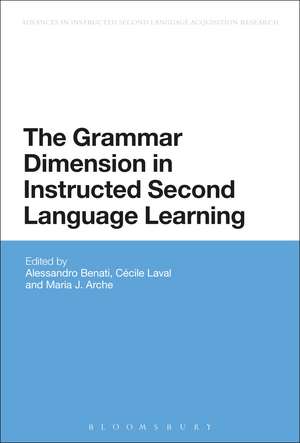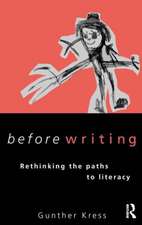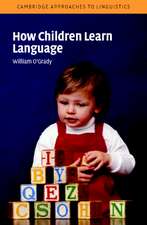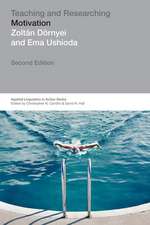The Grammar Dimension in Instructed Second Language Learning: Advances in Instructed Second Language Acquisition Research
Editat de Professor Alessandro G. Benati, Cécile Laval, María Archeen Limba Engleză Paperback – 24 iun 2015
| Toate formatele și edițiile | Preț | Express |
|---|---|---|
| Paperback (1) | 256.67 lei 6-8 săpt. | |
| Bloomsbury Publishing – 24 iun 2015 | 256.67 lei 6-8 săpt. | |
| Hardback (1) | 948.75 lei 6-8 săpt. | |
| Bloomsbury Publishing – 18 dec 2013 | 948.75 lei 6-8 săpt. |
Preț: 256.67 lei
Preț vechi: 294.97 lei
-13% Nou
Puncte Express: 385
Preț estimativ în valută:
49.12€ • 52.52$ • 40.95£
49.12€ • 52.52$ • 40.95£
Carte tipărită la comandă
Livrare economică 17 aprilie-01 mai
Preluare comenzi: 021 569.72.76
Specificații
ISBN-13: 9781474243360
ISBN-10: 1474243363
Pagini: 224
Dimensiuni: 156 x 234 x 12 mm
Greutate: 0.32 kg
Editura: Bloomsbury Publishing
Colecția Bloomsbury Academic
Seria Advances in Instructed Second Language Acquisition Research
Locul publicării:London, United Kingdom
ISBN-10: 1474243363
Pagini: 224
Dimensiuni: 156 x 234 x 12 mm
Greutate: 0.32 kg
Editura: Bloomsbury Publishing
Colecția Bloomsbury Academic
Seria Advances in Instructed Second Language Acquisition Research
Locul publicării:London, United Kingdom
Caracteristici
Asks how we incorporate a teaching grammar component into communicative language teaching.
Notă biografică
Alessandro Benati is Professor in Applied Linguistics and Second Language Studies and Director of Research and Enterprise at the University of Greenwich, UK.Cécile Laval is Principal Lecturer in Applied Linguistics, French & International Studies, University of Greenwich, UK.Maria Arche is Senior Lecturer in Applied Linguistics, French & International Studies, University of Greenwich, UK.
Cuprins
List of contributors Foreword Roger Hawkins Acknowledgements Introduction: Grammar Dimension in Instructed Second Language Learning Alessandro Benati, Cecile Laval, and Maria Arche Part One: Theoretical and Pedagogical Developments Chapter 1. Against Rules Bill VanPatten and Jason Rothman Chapter 2. Possibilities and Limitations of Enhancing Language Input: a MOGUL perspective Mike Sharwood-Smith Chapter 3. Processing Instruction: Where research meets practice James Lee Chapter 4. Collaborative Tasks and Their Potential for Grammar Instruction in Second/Foreign Language Context María del Pilar García Mayo Chapter 5. Interactional Feedback: Insights from theory and research Hossein Nassaji Part Two: Empirical Research Chapter 6. Instructed SLA as parameter setting: Evidence from earliest-stage learners of Japanese as L2 Megan Smith and Bill VanPatten Chapter 7. The Relationship between Learning Rate and Learning Outcome for Processing Instruction on the Spanish Passive Voice James Lee Chapter 8. Coproduction of Language Forms and Its effects on L2 Learning Hossein Nassaji and Jun Tian Chapter 9. Raising Language Awareness for Learning and Teaching L3 Grammar Tanja Angelovska and Angela Hahn Index
Recenzii
This is an excellent collection of papers concerned with theory, pedagogic developments and empirical research on the complex role of grammar instruction in second language learning. Essential reading for language teachers, researchers of second language acquisition and educators.
Combining chapters describing the theoretical motivation for such pedagogic interventions as `input enhancement`, `processing instruction` and `interactional feedback` with chapters reporting careful empirical studies of the effects of these and other interventions on developing knowledge of L2 grammar, this book is an excellent example of how Second Language Acquisition research can contribute to effective L2 pedagogy. Each chapter is authoritative, accessible, and the range of issues the book deals with in learning grammar is wide. The result is a very valuable contribution to our understanding of how instruction can facilitate L2 learning.
The particular strength of this book is the linkage it creates between theory based in linguistics and evidence-based practice research.
Reviewed
Combining chapters describing the theoretical motivation for such pedagogic interventions as `input enhancement`, `processing instruction` and `interactional feedback` with chapters reporting careful empirical studies of the effects of these and other interventions on developing knowledge of L2 grammar, this book is an excellent example of how Second Language Acquisition research can contribute to effective L2 pedagogy. Each chapter is authoritative, accessible, and the range of issues the book deals with in learning grammar is wide. The result is a very valuable contribution to our understanding of how instruction can facilitate L2 learning.
The particular strength of this book is the linkage it creates between theory based in linguistics and evidence-based practice research.
Reviewed

































